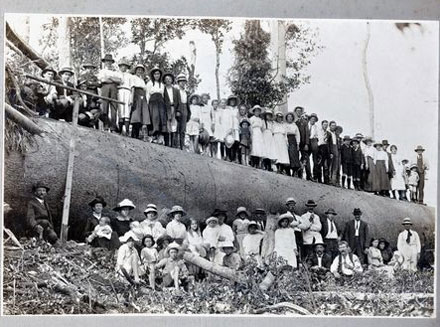
Gympie’s timber history began in earnest soon after gold was discovered in 1867 by James Nash, and the industry has been at the heart of Gympie ever since. Source: Gympie Times
Following alluvial fossicking, and when mining began, timber became vital for the safe construction of mine shafts.
As soon as Governor Gipps declared the Moreton Bay region was no longer a penal colony, free settlement began. The population increased and so the need for timber followed.
Farming and agriculture also added to the reason for the growth of the timber industry. In the early days of Gympie development, there was no through road nor railway to Maryborough and this included suitable bullock wagon tracks.
Instead, logs were transported to Maryborough along the Mary River, with light wood such as red cedar, white beech, hoop and bunya pine the principal and best known species.
While some logs may have been floated downstream singly, logs were mainly tied together as a float group of about six.
Local sawmills were built to supply local needs.
In the early timber industry, the snigging and hauling of logs was done mostly by bullock teams.
The timber was cut in the forest using cross-cut saws, axes, wooden mauls and iron wedges. Men were not the only timber cutters in the region; the Lynch sisters are remembered by the State Forest area named Lynches Hill, 4.1km west of Gympie on the Glastonbury Rd.
Timber from the Cooloola Coast was winched to a wooden rail tram line (recorded as Pettigrew’s tram line) loaded on to wagons and hauled by the steam engine, Mary Ann, to Poverty Point near Tin Can Bay. There it was loaded on to a large barge and taken to Maryborough, because there were no suitable haulage roads to Gympie.
Much later on, as sand mining moved into the Cooloola area, mining companies built the access road which linked Tin Can Bay and Gympie.
In 1889, Richard Hyne (Maryborough MP) pushed for a Department of Forestry to be established by parliament and 11 years later the department was declared. State forests were established because private land was being cleared and timber was being wasted.
The new land was cleared to grow fruit and vegetables in the scrub soil. Dairying and other farming needs added to the waste, because the timber was often difficult to harvest and the price of timber was low at the time.
As the demand for quality timber increased, sawmills flourished in all districts. Such was the growth in the industry that by 1926, annual limits were placed on logging quotas obtained by sawmills from state forests.
Between 1917 and 1920, trial plantings of pine in the Imbil area were carried out to find the best way to grow plantation timber.
As the population increased, the industry grew and by 1925 there were 257 sawmills in the wider Moreton Bay and Wide Bay regions. As part of this expansion, Gympie had a significant number of sawmills resulting in the greater use of local sawn timber.
By 1950, trees were marked for cutting in state forests. A classic example of the success in forest management is the sustainable timber volume in State Forest 451 (Cooloola, now National Park).
An important factor in improved regeneration was the controlled burning of forest fuel during the cooler months of the year. This prevented bush fires in hotter weather, which damaged growing trees – as a result there was a much-increased volume.
In 1981, the then District Forester Peter Cranny (Gympie) arranged for the then Gympie District Marketing Officer (George Venz) to select suitable trees from State Forest 451 for timber to be used in the construction of the Woodworks Museum.
The principle timber species elected was tallow wood, spotted gum and yellow stingy bark. The museum was officially opened in 1984, by minister Bill Glasson.
In the 1980s, private landholders sought advice in forest management. The then Forestry Department generally did not aid private landholders.
In 1988, the first private business to assist land holders was GM Timber Advisory Service, with a coverage to the private sector in south and central Queensland.
By 2003, the Private Forestry Service Queensland aided land holders who wanted to promote timber growth in conjunction with cattle grazing.
In 1990, the Queensland government removed departmental status from Forestry and placed it under control of the DPI (Department of Primary Industries). In the years following, stands of plantation timber were sold to private companies.
Logging and deforestation has been a hot topic in recent years, with Labor and Coalition governments successively taking office and both taking opposite sides of the discussion.
Allegiances aside, logging and timber have formed an important piece in Gympie’s development over the course of its 150 years.





